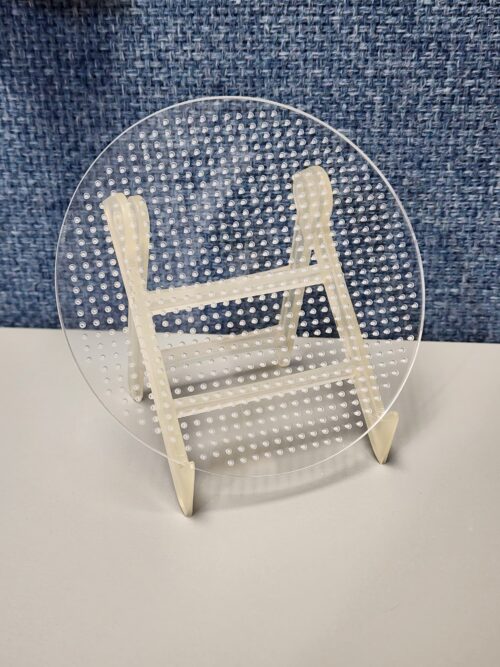Micro-electromechanical systems (MEMS) combine mechanical and electrical capabilities into a single glass wafer. Nearly every industry has found a way to integrate these tiny devices into their production lines, including the automotive, semiconductor, medical, communications, and consumer electronics industries. In fact, the consumer electronics market is projected to grow about 8.6% annually, in large part thanks to the rise of MEMS technology.
Learn more about MEMS, why glass is the ideal substrate for them, and our fabrication capabilities.
What Are Micro-Electromechanical Systems (MEMs)?
MEMS are minuscule, powerful integrated devices or systems that combine electrical and mechanical components. MEMS fabrication involves integrated circuit (IC) batch processing techniques, using glass wafers as substrates. MEMS devices can detect, control, and actuate micro processes, creating effects on a macro scale. The final product ranges from a few millimeters to less an a micrometer in size, which is smaller than the width of a human hair.
“MEMS” was coined in a 1986 technical paper to the Defense Advanced Research Projects Agency (DARPA) and has since become the term that describes the fabrication of tiny electromechanical devices as well as the devices themselves. Fabrication of a MEMS may not include mechanical components, but they are still termed MEMS because of their size and structure. They are known in Europe as microsystem technology (MST) and in Japan as micromachines.
Uses of MEMs

From their humble beginnings in the early 1950s, MEMS have since journeyed from research labs to everyday consumer products. MEMS started appearing in commercial applications like airbags in cars, inkjet printers, and medical-grade pressure sensors in the mid-1990s. Today, these devices are even more ubiquitous—every new car contains at least 50 MEMS, for airbags as well as mandated safety systems, tire pressure monitoring systems, and electronic stability control.
Another example of MEMS that people use every day is the system on a chip (SOC) on smartphones that automatically changes screen orientation. As MEMS require less power, become smaller, and become less expensive to fabricate, these devices will play a key role in home automation and Internet of Things (IoT) ecosystems.
Common applications containing MEMS include:
- Heating and cooling systems in buildings driven by sensors
- High-definition projection using micromirror arrays
- Detecting subtle changes in cleanrooms and other nanotechnology manufacturing environments
- Inkjet printer micronozzles
- Mobile app integration of gyroscopes, accelerometers, barometers, and microphones
- Disposable medical pressure sensors
- Optical switching devices to control signals
Components of MEMS
MEMS contain mechanical microstructures, microactuators, microsensors, and microelectronics, integrated into a single chip. Microsensors sense changes in the device’s environment by monitoring thermal, chemical, mechanical, or electromagnetic information. Microelectronic components process this data and signal the microactuators to react to these changes.
The Rising Importance of Glass for MEMs
Silicon has long been the material of choice when fabricating MEMS, but researchers and manufacturers have identified alternative substrate materials that offer the same or more benefits than silicon. Some of these options include glass, quartz, metals, crystalline insulators, polymers, and ceramics.
In particular, the MEMS and electronics industries use glass as substrate carriers and in wafer packaging. Glass carrier substrates are preferable because of their chemical resistance and thermal stability. For medical device applications, glass wafers provide airtight MEMS enclosures. Glass wafer packaging offers greater functionality and reliability over time and in harsh operating conditions. Overall, glass is a desirable alternative to silicon for its lower cost, biocompatibility, and optical transparency.
Microfluidic devices also tend to use glass because of its chemical inertness and receptiveness to coatings. Four common applications of glass MEMS micromachining for microfluidics include:
- Flow cell and flow cell components
- Slides manufacturing
- Lab on a chip
- Bio-MEMS
MEMS glass fabrication is also popular for producing cost-effective, high-performance, and flexible microprocessors. As MEMS glass fabrication advances, so will the need to develop better micromachining methods. Traditional methods like CNC machining are ineffective on brittle glass materials. Fabrication methods must also adapt to the increasing diversity of MEMS applications, as features shrink in size and become more complex.
Learn More About Swift Glass’s Capabilities
Swift Glass has over 80 years of experience in glass design and fabrication, including MEMS glass wafers. Whether you need standard or custom-designed glass wafers, we use high-quality materials, advanced cutting and finishing tools, and a wealth of industry expertise. To learn more about glass wafers for the MEMS industry, download our eBook, “Glass Fabrication for MEMS Applications.” To begin your glass wafers for the MEMS industry fabrication project, contact Swift Glass or request a quote.



